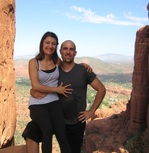As we visit each new country, one goal we have is to challenge ourselves with a mental task (like language acquisition) as well as a physical skill developed by that culture. The inspiration for this came from Tim Ferris, one of our favorite lifestyle design authors. We see this type of challenge as the perfect way to continue to grow while traveling. It can be easy to become a passive observer of a culture as one travels - just consuming, observing, and judging, as is typical for our minds. But to challenge oneself to immerse in that culture and learn a few of its contributions to the pool of human knowledge is a perfect way to stay physically and mentally sharp. Whether at home or traveling abroad, it seems crucial that everyone find their own "stagnation stoppers" to keep life interesting and to fight off the sleepy malaise that can so easily take hold of body and mind. 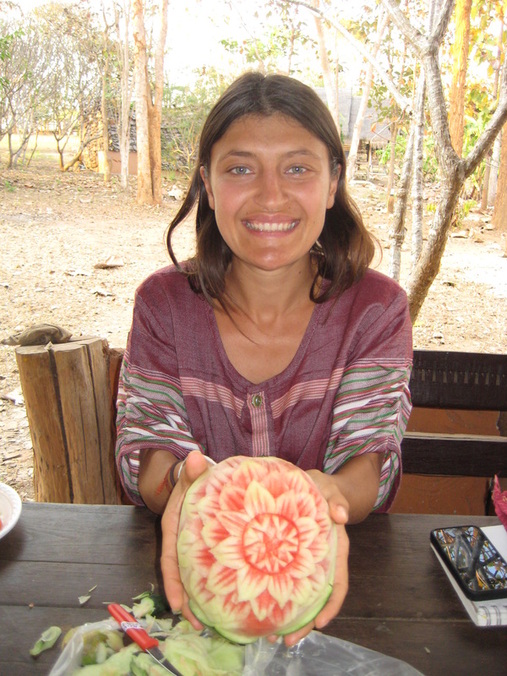 Neda practicing her vegetable carving - another Thai skill she is picking up... For the major physical skill here in Thailand, we are doing a month long Thai massage training. We got interested in Thai massage during our wonderful yoga teacher training at Dharma Yoga, where one of our guiding teachers, Camilla Figueroa introduced us to the basics of the practice and philosophy. So what is Thai Massage? I like the description of massage therapist Nephyr Jacobsen, who says: "I've done deep-tissue Swedish massage for 17 years. I mean really deep; no fluff-and-buff stuff here. But it doesn't come close to Thai massage, and nothing I've seen does. It's yoga and Rolfing and acupressure and tapotment and chiropractic and reiki and deep compression work and myofacial release and hydrotherapy with herbs and the power of spirit, all rolled into one." We spent a few days in Chiang Mai researching the different schools and found an amazing teacher that learned Traditional Thai medicine and massage from her grandparents. These techniques were passed down for generations in her family. She has since been certified as a Doctor of Traditional Thai Medicine and Thai Massage, but still cherishes the oral and tactile lineage by which she learned. Her estate is about 9 km from Chiang Mai - check out the site here. We are staying in house #4 – isn’t it beautiful? 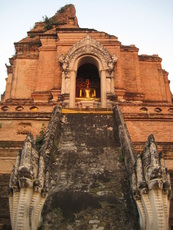 Wat Chedi Luang As for our time in Chiang Mai, we found it to be a city full of growth - for good and ill. On the positive side the city has seen many ex-pats settle within its old walls, leading to a fascinating mix of people. One fellow we met was good friends with Glen Campbell back in the day and drove Merle Haggard to Capital Records to cut his first single! The city is also full of the wonderful temple architecture of the Lanna Kingdom, of which it was once the capital. On the negative side, Chiang Mai seems like it is bursting its britches a bit, with lots of traffic and poor air quality unfitting of such a beautiful mountain location.
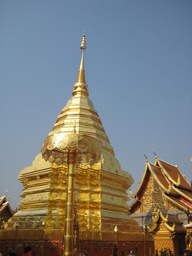 Wat Doi Suthep Like our massage training, which is located 9km south of Chiang Mai, we found that many of our favorite parts of Chiang Mai lie just outside of it. Wat Doi Suthep is a beautiful temple on the mountains surrounding Chiang Mai and the San Kamphaeng Hot Springs and Muang On Caves were great Thai tourist attractions to visit with the locals! At San Kamphaeng we were able to boil quail and chicken eggs in the sulfuric waters, making for a delicious breakfast! We also spent Valentine's Day here and had a really special Thai dinner - Khantoke, where a small tray of several different dishes is served with rice and a whole bowl of fresh herbs! For all the pictures, see this link: http://flic.kr/s/aHsjyNZ2En.
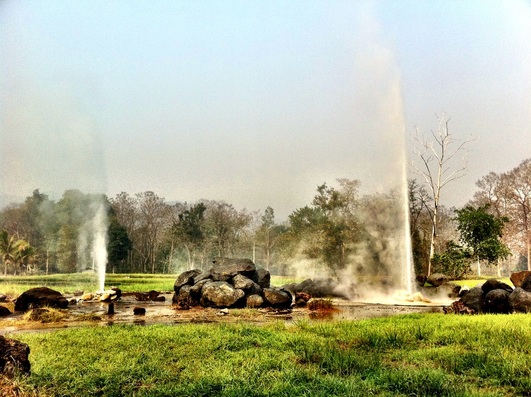 San Kamphaeng Hot Springs - measuring 105 degree Celsius 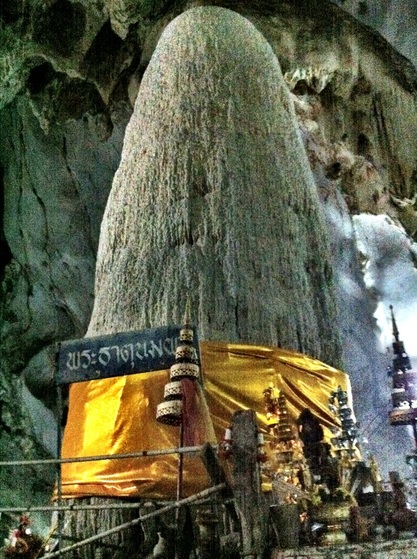 A giant stalagmite in Muang Cave Our massage training starts tomorrow and with it comes some stability for the next month. In the meantime, we had a wonderful visit to the mountain towns of Pai and Suppon while we waited for the training to start, so we'll post a blog on those experiences in the days to come.
We have been in Thailand almost 6 weeks now, and are getting increasing insight
into Thai Culture. The Thais have a saying, “same same but different,” and that
is exactly how we feel about Thailand and its people. Every day we find
connection in our similarities and enrichment in our differences. We thought
we’d discuss a few of those insights here.
As we traveled through Southern Thailand, we noticed a great amount of attention
placed on the feet. Thais always take their shoes off prior to entering a home
(which is how it is in Bulgaria as well), but they take it to another level by
taking their shoes off in the stores such as pharmacies, grocery stores,
minimarts, etc. It is also considered rude to sit with the soles of your feet
facing a person (or an image of the Buddha). So might be hard to have your legs
up on the coffee table in Thailand!
We also noticed that people in the South were more reserved in their clothing -
probably due to the major Muslim influence of Malaysia. Usually, women would not
wear tops that show their shoulders and would never wear bikini. They just go in
the water fully clothed (as do Thai men). As we have reached the North, women
seem to be more lax about these restrictions but are still a lot more modest
than their Western counterparts.
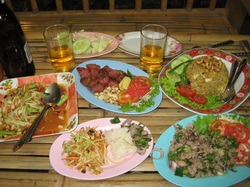 Regarding food and etiquette, it is interesting to note that Thais eat primarily with spoons. At each meal, you are served a fork and a spoon, but the fork is only used to push food onto the spoon. The Thais believe it is uncouth to eat with your fork! We have really taken to eating with our spoons now and it is actually much easier, especially with the rice-centric dishes of Thailand. The Thais are also much more lax related to “food safety”. Eggs are never refrigerated, even in grocery stores, and cooked foods will often sit for purchase for hours in the open air markets. While we did get a few stomach bugs in the South (primarily from seafood we think), so far we have been surprised by how this seems to work and how anal we can be about it in Europe and the US.
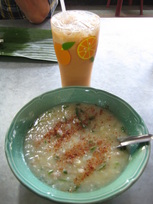 The one thing that Jeff talks about missing the most is breakfast. There is one breakfast dish here, jok – a rice porridge with a crazy amount of ginger, garlic, cilantro, and a few pieces of meat. It is quite delicious and really good for digestion but it can be hard to find, especially in tourist prone areas. For the most part we see Thais eating the same dishes for breakfast as they do for dinner. We still haven’t had a really spicy curry for breakfast yet – not sure my stomach can handle such a start!
As we are immersing ourselves in Thai culture, which includes learning Thai, we are noticing that Thai verbs don’t have a past tense. This is quite intriguing from a Buddhist perspective. Would a linguistic lack of a past tense necessitate a greater connection to the present moment? Regardless, it does lead to a greater chance for confusion. Native Thai speakers have told us that formal conversations often have multiple questions strewn throughout to clarify things like tense, number, etc… What Thai lacks in complexity in those areas it makes up for with its five different intonations – the word ‘khao’ means 5 different things depending on how it is pronounced! And the alphabet is just insane with 44 consonants, each with an inherent vowel, and 18 other vowels.
As you can see, travel is an endless observation of Same Same But Different, a Thai adage that neatly summarizes life.
Neda and I visited Mae Sot last week. It’s a border town 7km from the Burmese border with a mixture of Thai, Burmese, and ethnic hill tribe peoples (many of whom come from Burma). This leads to a wonderful cultural mix with a diverse array of clothing (many men wear the Burmese longyis, or sarongs), crafts, languages, and food. But unfortunately, there is a dark side to the diversity. Outside of Mae Sot are 3 large refugee camps serving as home for over 100,000 displaced Burmese. They have fled the despotic military junta that currently reigns over Burma. We had the opportunity to volunteer at one of the migrant schools set up to educate the child refugees living in the area. The school, named Agape, is like other migrant schools in that it receives no funding from the Thai government, relying only upon international aid and donations to function.
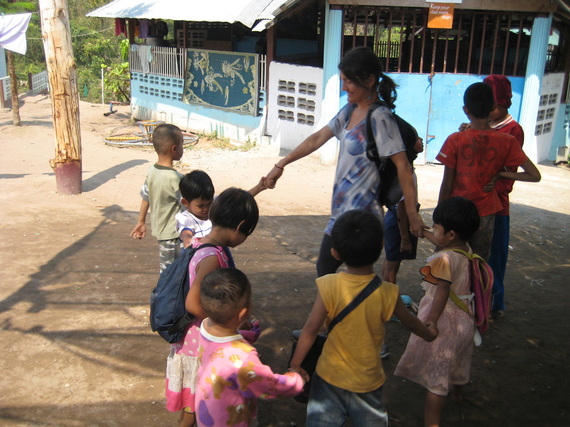
Neda with kids from Agape
The stories we heard about the children living there need to be heard by more people, which is why we are writing this post. Some families in Burma can’t leave but want to send their children to Thailand so that they can have a better life. To be smuggled across the border they have to pay a “transporter”the equivalent of about $90. Of course they don’t have that kind of money so they are told the children can pay back the transporter when they arrive to work in Thailand. Once the kids are smuggled across, they are thrown into sweat shop factories run by local Thais and forced to work for years to pay off their debt. Or they are shipped around Southeast Asia and forced to work as sex slaves. One volunteer told us the heartbreaking story of a 9 year old Burmese girl who had been trafficked into Malaysia. They had to stop her from teaching the other kids the Malaysian she had learned because it was all related to explicitly sexual acts. She didn’t even know what she was saying.
Mae Sot is awash in begging children. David, the founder of Agape School, told us that many of these kids are being forced to beg by their parents. Sometimes the parents live in Thailand after having crossed the border and sometimes the kids cross the dangerous river border and come across to beg, or as is more often the case, act as drug mules. The kids are less hassled by police and as such are now the most common drug dealers to be found in the streets of Mae Sot. It certainly gave me some perspective about “being put in the middle” to hear the stories of these children who are used only as tools by their parents or others.
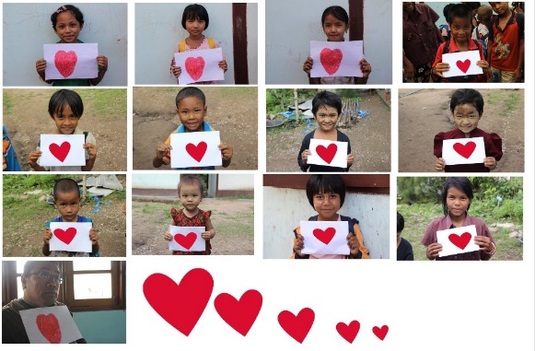
The kids of Agape and at the bottom the volunteer who introduced us to them
It’s the height of injustice that the most innocent in our society are those most often caught in the middle between people’s greed and delusion. The cynic can focus on all the suffering present in the place, though the optimist can point to people like David, who founded the Agape school with nothing but grit and determination. You can read a bit about his story by clicking here and see their facebook page, set up by a volunteer we befriended, here. In the end, as with all suffering, the first step we can take is to bring awareness to it. Suffering feeds on ignorance and distraction – the more light of awareness we can bring to the children of Mae Sot, the more the momentum for change will grow.
Neda and I often talk about just what it is we are doing on this mini-retirement/travel the world extravaganza. Sure, we want to experience diverse languages, foods, and climates, and we hope to make new friends and gain insights about the world. But in the end, we have distilled it down to one coined word: wonderlust. The desire to constantly have wonder in one’s life, whether one is trotting the globe or grinding through the typical work
week. It is wonder that inspires us to create, to love, to truly feel alive.
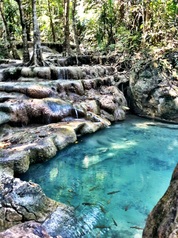 the fish awaiting their meal This past week has had no shortage of wonders. It started with the long trip from Southern Thailand up to the Kanchanaburi province of Central Thailand. Kanchanaburi contains the 7-tiered Erawan Waterfall, where each aquamarine curtain flows into a rippling pool fit for swimming before continuing on to the next fall. In each pool, a variety of fish will be swimming with you, some of which love to eat the dead skin cells off your legs and feet. It is a wondrous experience to take part in this temporary symbiotic relationship as the fish get some food and you get nature’s pedicure.
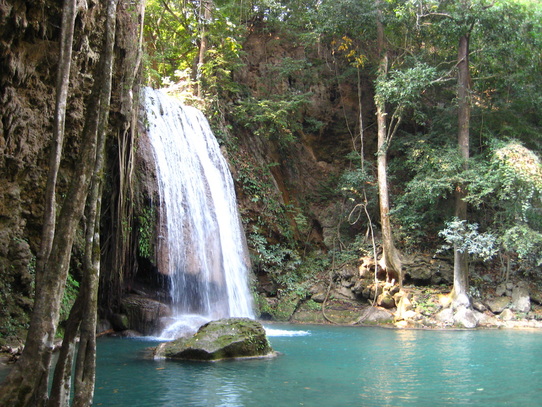 One Tier of the Erawan Falls Kanchanaburi also contains the infamous bridge over the River Kwai, built by Japanese captured POWs under horrid conditions during World War II. In total, thousands of soldiers from America, England, Australia, China and other countries lost their lives building the Siam-Burma railroad that runs through Kanchanaburi. It is here that we paused in wonder at how cruel man can be to his fellow man when greed and hatred reign the psyche. To see all the pictures from Kanchanaburi, both waterfalls and the bridge, go this link: http://flic.kr/s/aHsjyuhX64 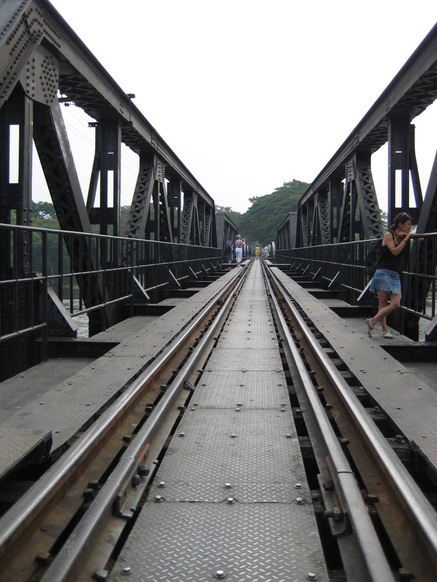 Contemplating the Bridge Over the River Kwai 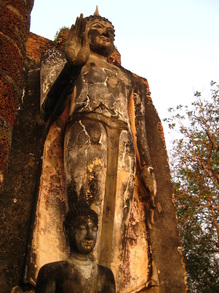 Buddhas at Sunrise Next, we headed north into the Central Plains of Thailand to visit the ancient city of Sukhothai. Established in the middle of the 13th century, this vast kingdom (considered to be the first distinctly “Thai” kingdom) ruled from the capital city for almost 200 years. As Neda and I bicycled through the 70 square kilometers of ruins at the site, we couldn’t help but marvel at the beautiful art and architecture that remains and at the obvious power of this kingdom that has long since faded to the sands of time. We watched the sun rise over the ancient city with our backs to a 45 foot Buddha on a hill outside of town – the same Buddha that the king of Sukhothai would visit on his white elephant come every Buddhist Sabbath. To see the rest of the wonderful pictures of the city of Sukhothai, go here: http://flic.kr/s/aHsjywxYDc
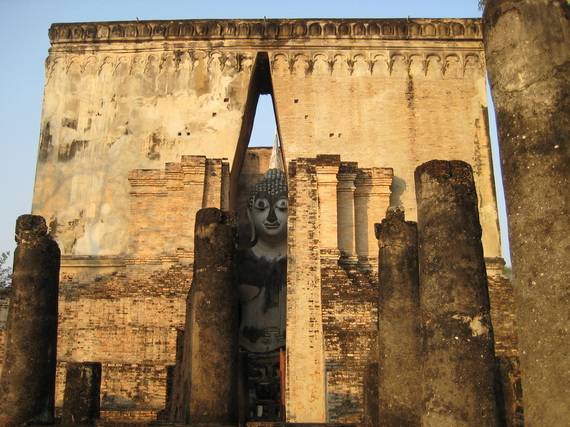 The peeking Buddha of Wat Si Chum 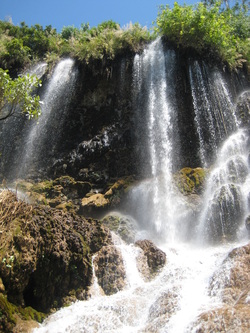 The Thararak Falls Finally, we headed west to a border town called Mae Sot. Sitting just 7 km from the Thai border with Burma, Mae Sot is a cultural melting pot of Thai, Burmese, Chinese, and native hill tribe peoples. We’ll go into that more in another post, but today we rented a motor bike and did a self guided tour of the Thararak, Pha Charoen, and Pa Wai Waterfalls, located over a 50 km stretch from the city. Each waterfall brought its own unique wonder, ending with the Pai Wai falls, the most mystical and enchanted waterfalls we have ever seen (see below). We left with a smile on our face and a sense that we will always carry with us the beauty we had seen – perhaps as an inspiration when wonder seems hard to find. To see the pics so far of Mae Sot, including the waterfalls and our visit to the Burmese Wat, click here: http://flic.kr/s/aHsjyBUtvM
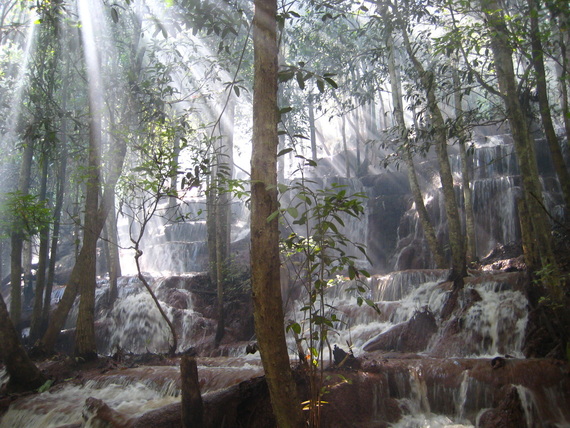 The enchanted Pai Wai Falls And yet all these amazing sites paled in comparison to the most wondrous event to happen this week in our lives. While traveling, we found out that our niece Ella spoke her first word! Even as we find wonder in our travels, our hearts are with my brother Dan and his wife Lauren as they find wonder in the little girl they have brought into the world. We love you Ella! Oh, and her first word was “cheese” in case you were "wonder"ing… 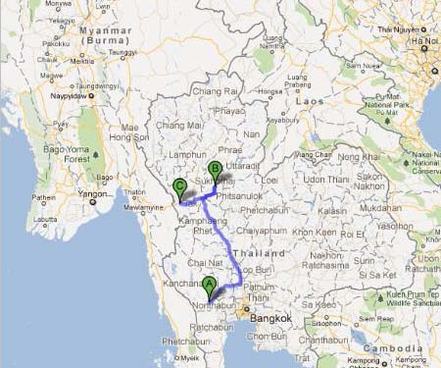 Our journey on this leg of the trip
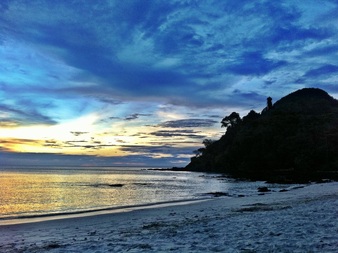 Sunset at Ko Mook "living plants are supple and yielding
dead branches are dry and brittle
an inflexible army does not triumph
an unbending tree breaks in the wind
thus the rigid and inflexible will surely fail
while the soft and flowing will prevail"
Excerpt from Tao Te Ching – Lao Tzu – chapter 76
It has been very intriguing to experience life as an extended traveler. It is
full of new adventures every day, new people to meet, new foods to taste...just
newness. And yet the constant change makes one crave the creature comforts we
are used to in the States and Bulgaria. Here in Thailand we have had to get used
to cold showers, non-potable water (you have to buy drinking water everywhere),
no toilet paper in any bathrooms (BYOTP), stomach bugs, and sleeping on the
floor or surrounded by mosquitoes with only a thin net protecting you. At first,
we resisted some of these experiences and were like a stiff tree breaking in
the wind. It only caused suffering and took us away from the experience. So we
have been practicing shedding our preferences here in Thailand. To be o.k. with
the shock of the cold water as it hits your skin or the buzz of the mosquitoes
in your ear. It is in this way that travel makes us more pliant and more
flexible and in the end, much happier.
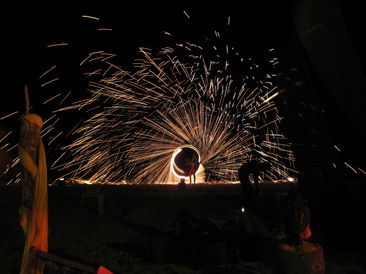 A fireshow on the beach in Ko Lanta As for the traveling, we loved our stay in Ko Lanta, especially after the business of Ko Phi Phi. It is a beautiful island covered in sprawling forest and jungle with multiple beaches lining its 30 km long coast. We stayed on the longest beach (3km long) and enjoyed fire shows, beautiful sunsets, and just simple "beach bumming". We also hiked through the jungle to get to Khao Mai Kaew cave where a local guide kept us safe while pointing out sleeping bats and giant spiders in the enshrouding darkness of the cave. See our pics from Ko Lanta here - http://flic.kr/s/aHsjyrxvQF.
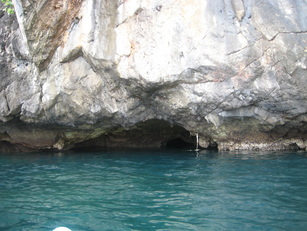 In the end, we couldn't resist one more island and headed to Ko Mook to see the famed Emerald Cave. To get into the cave, we sea kayaked from the beach around the island to this little hole in the limestone (see to the right). We passed through an 80 meter long tunnel partially in darkness and partially lit by the luminous green glow of the water within (thus the name of the cave). As we emerged through the other side, we were awestruck by the beauty of the lagoon within. All tourists had vacated and we were treated to turquoise water and a private beach surrounded on all sides by towering cliffs and lush forests. The lagoon is barely accessible by land, making the journey all the more spectacular. In fact, pirates used to store their treasures here back in the day. See the video of us emerging from the pitch blackcave into this little heaven! Also, check out all the pics from Ko Mook here - http://flic.kr/s/aHsjyrzPwg.
So now that the islands are done we have headed north. We took an overnight train from Trang to Kanchanaburi (via a stop over at Nakhon Pathom to see Phra Pathom Chedi, the largest Buddhist monument in the world) and are looking forward to exploring the northern parts of Thailand. Here is a map of our island hopping journey and our movement on the night train: 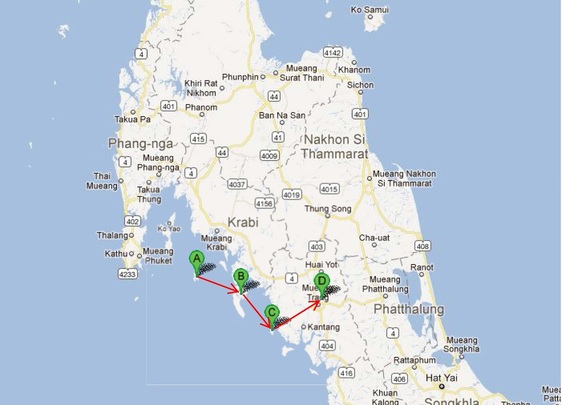 From A) Ko Phi Phi to B) Ko Lanta to C) Ko Mook to D) Trang 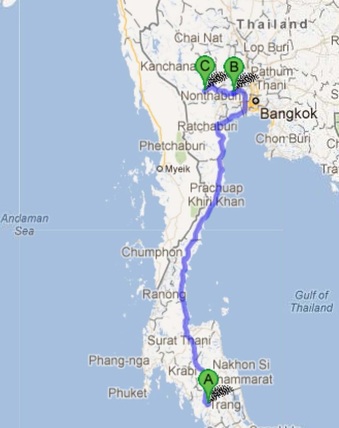 From A) Trang to B) Nakhon Pathom for a short stopover and then to C) Kanchanaburi
|






















 RSS Feed
RSS Feed